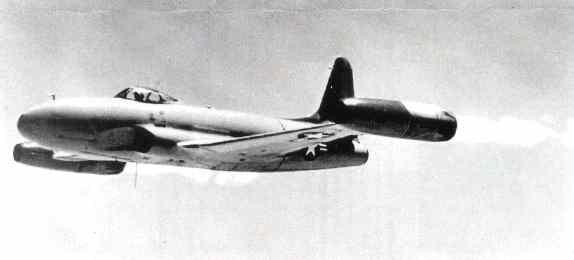One of
the first jet propulsion technologies was the ramjet.
The Russians began ground testing of ramjets in April of
1933, flight tested one on the front of an artillery
shell in September of 1933, and began testing them on
manned aircraft (starting with a Polikarpov I‑ I 5bis
biplane) in December 1939. The Germans flight‑tested
ramjets during WWII and the US Navy tested a
ramjet‑powered missile in 1945. The United States tested
German ramjets on the wing tips of a P‑51 in 1946, but
this aircraft was lost in a mishap. Marquardt developed
three ramjet engines, two of which were flight tested on
two F‑80s and an XF‑83, both of which were powered by
J33 engines. The Marquardt ramjets were 20, 30, and 48
inches and diameter. The first flight of the 'F‑80
Trijet', with 20 inch diameter ramjets operating,
occurred on December 3, 1947 at Wright Field. The first
flight with the 30‑inch diameter ramjets was made on
April 1, 1948, at Edward Air Force Base. About 100
flights were made by this aircraft including flights in
which the J33 was shut down and flight was sustained by
ramjet power alone. It was reported that the aircraft
flew at 500 mph on the ramjets The picture below shows
the F‑80 flying with the 30 inch diameter ramjets
operating. The 48‑inch ramjet was never test flown.
Three
ramjet‑powered manned aircraft designs were built and
flown in France by the Leduc Company beginning in 1946.
Because ramjets produce no static thrust these aircraft
were carried aloft on the top of larger aircraft and
dropped off before the engine was started. They achieved
Mach numbers of about 0.85, but were limited to fairly
short flights because of high fuel consumption.
Although
ramjet engines will operate at subsonic speeds, subsonic
ramjets are notoriously inefficient in that they use a
lot of fuel for the thrust they produce. Typically jet
engines become more efficient as the compression ratio
is increased. Since ramjets rely on converting forward
speed into pressure their compression ratios are very
low subsonically. The French ASR900 ramjet produced 25
10 lb. of thrust at sea level and 620 mph but had a
specific fuel consumption (SFC) of 5.7 lb./hr/lb. of
thrust. This is about 8 times the SFC of a good
turbojet. Supersonic speed improves the specific fuel
consumption, and the ramjet is a good low cost engine
for an expendable application. Supersonic ramjets have
been successful on these missiles: Boeing Bomarc,
Douglas Talos, North American Navajo, and Lockheed D‑21.
Allison
was involved in the development of a supersonic ramjet
using pyrophoric fuel in about 1960. The fuel was TEA
(Tri‑Ethel‑Aluminium), and it would ignite spontaneously
when sprayed into the combustion chamber, thus making a
typically simple engine even simpler.

